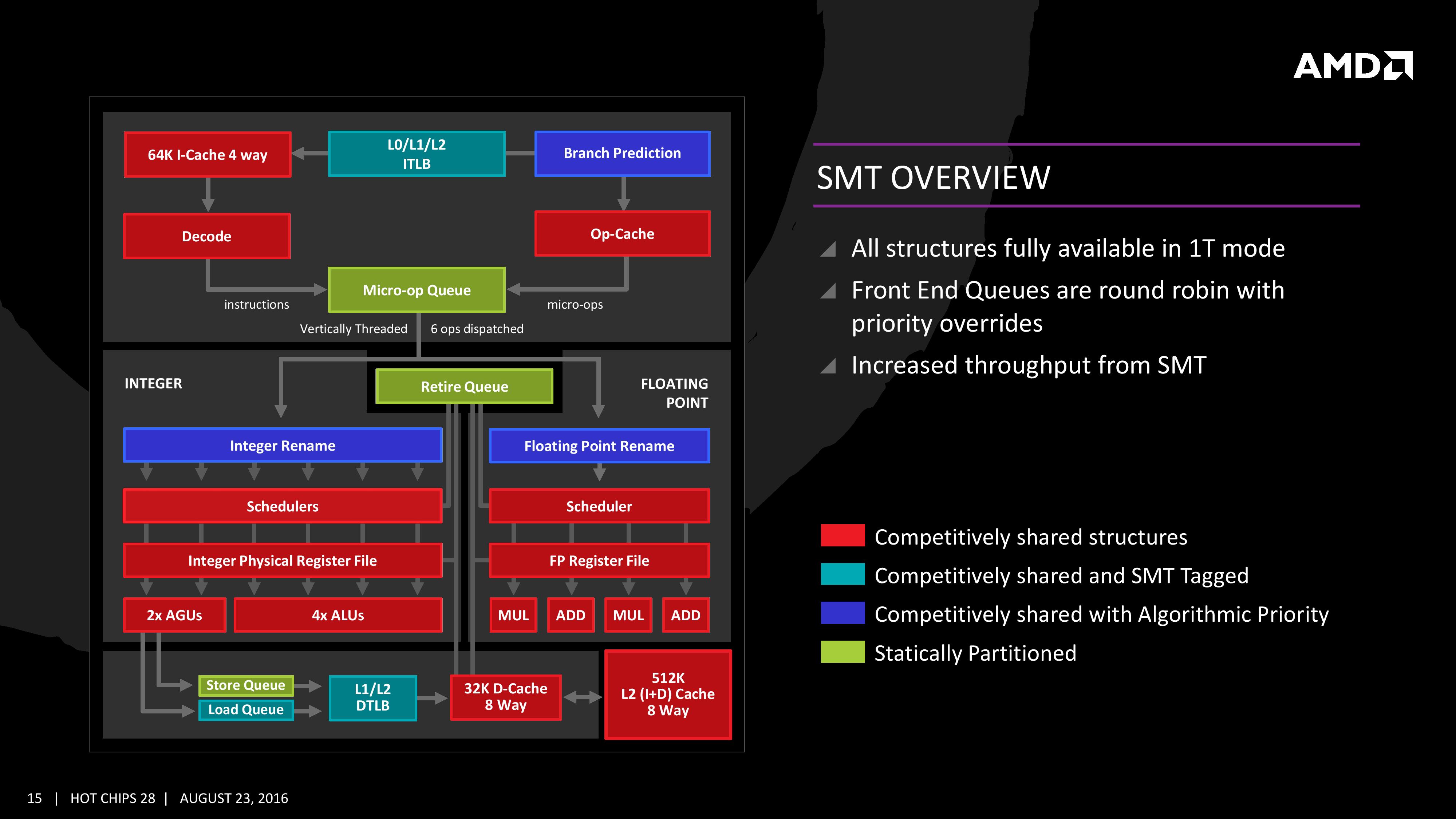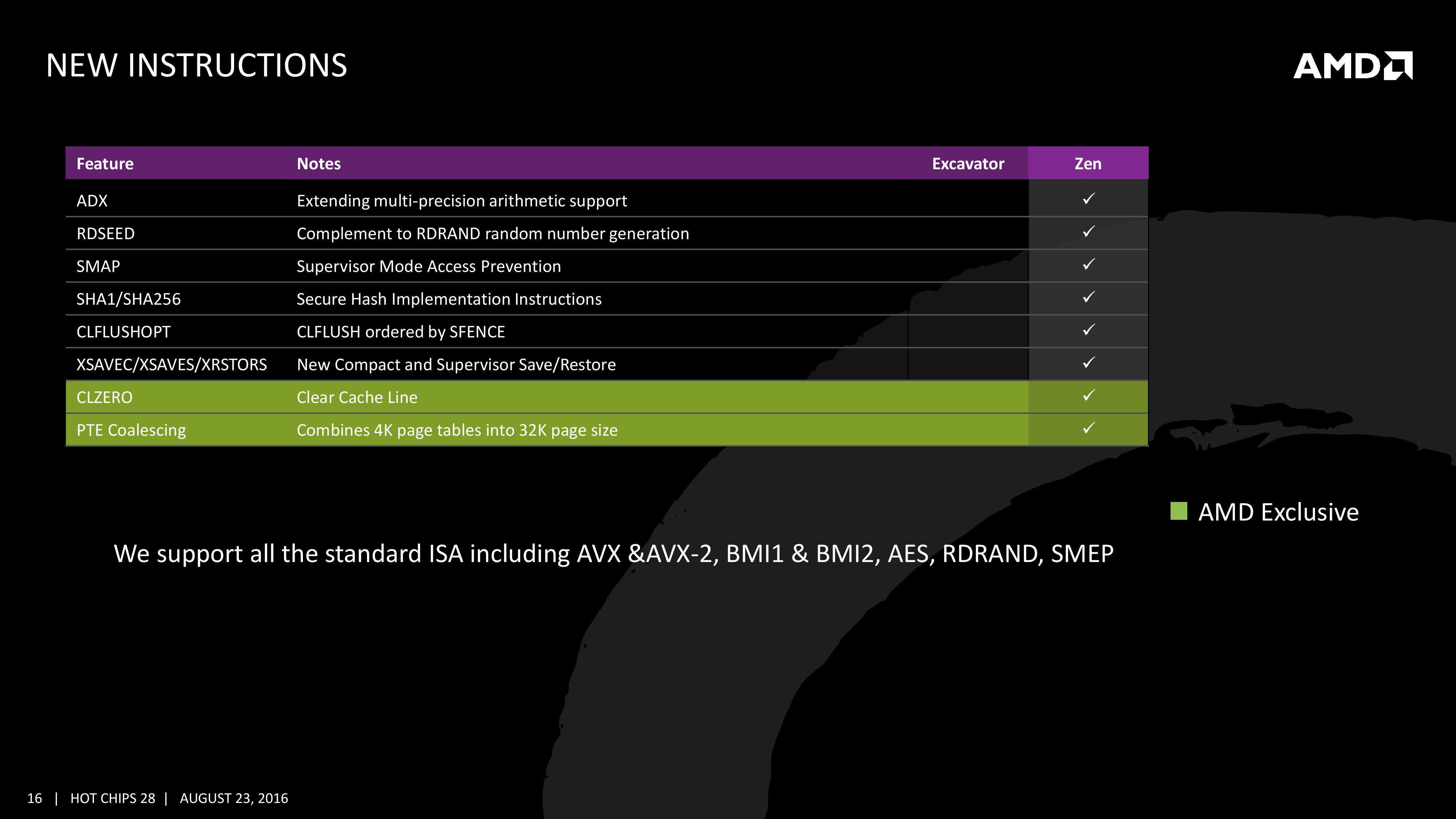The AMD Zen and Ryzen 7 Review: A Deep Dive on 1800X, 1700X and 1700
by Ian Cutress on March 2, 2017 9:00 AM ESTSimultaneous MultiThreading (SMT)
Zen will be AMD’s first foray into a true simultaneous multithreading structure, and certain parts of the core will act differently depending on their implementation. There are many ways to manage threads, particularly to avoid stalls where one thread is blocking another that ends in the system hanging or crashing. The drivers that communicate with the OS also have to make sure they can distinguish between threads running on new cores or when a core is already occupied – to achieve maximum throughput then four threads should be across two cores, but for efficiency where speed isn’t a factor, perhaps power gating/clock gating half the cores in a CCX is a good idea.
There are a number of ways that AMD will deal with thread management. The basic way is time slicing, and giving each thread an equal share of the pie. This is not always the best policy, especially when you have one performance dominant thread, or one thread that creates a lot of stalls, or a thread where latency is vital. In some methodologies the importance of a thread can be tagged or determined, and this is what we get here, though for some of the structures in the core it has to revert to a basic model.
With each thread, AMD performs internal analysis on the data stream for each to see which thread has algorithmic priority. This means that certain threads will require more resources, or that a branch miss needs to be prioritized to avoid long stall delays. The elements in blue (Branch Prediction, INT/FP Rename) operate on this methodology.
A thread can also be tagged with higher priority. This is important for latency sensitive operations, such as a touch-screen input or immediate user input elements required. The Translation Lookaside Buffers work in this way, to prioritize looking for recent virtual memory address translations. The Load Queue is similarly enabled this way, as typically low latency workloads require data as soon as possible, so the load queue is perfect for this.
Certain parts of the core are statically partitioned, giving each thread an equal timing. This is implemented mostly for anything that is typically processed in-order, such as anything coming out of the micro-op queue, the retire queue and the store queue. However, when running in SMT mode but only with a single thread, the statically partitioned parts of the core can end up as a bottleneck, as they are idle half the time.
The rest of the core is done via competitive scheduling, meaning that if a thread demands more resources it will try to get there first if there is space to do so each cycle.
New Instructions
AMD has a couple of tricks up its sleeve for Zen. Along with including the standard ISA, there are a few new custom instructions that are AMD only.
Some of the new commands are linked with ones that Intel already uses, such as RDSEED for random number generation, or SHA1/SHA256 for cryptography (even with the recent breakthrough in security). The two new instructions are CLZERO and PTE Coalescing.
The first, CLZERO, is aimed to clear a cache line and is more aimed at the data center and HPC crowds. This allows a thread to clear a poisoned cache line atomically (in one cycle) in preparation for zero data structures. It also allows a level of repeatability when the cache line is filled with expected data. CLZERO support will be determined by a CPUID bit.
PTE (Page Table Entry) Coalescing is the ability to combine small 4K page tables into 32K page tables, and is a software transparent implementation. This is useful for reducing the number of entries in the TLBs and the queues, but requires certain criteria of the data to be used within the branch predictor to be met.












574 Comments
View All Comments
theuglyman0war - Saturday, March 4, 2017 - link
I'd like to see a lot more older i7 extreme editions covered all the way to westmere so I can sell clients on new builds with such a comparison.mapesdhs - Sunday, March 5, 2017 - link
Which older i7s interest you specifically?theuglyman0war - Saturday, March 4, 2017 - link
Checking what I paid last month for i7-7700k at Microcenter...Although I did get the motherboard combo price sale they "usually" offer...
The supposed $60 off for $319 is the cheapest price I found with a quick survey of new egg, amazon etc... And only $20 less then what I paid! Hardly A slashed priced answer shot across the bow by Intel! Not by a long shot!
I thought I was going to recommend the new cheap price to all my customer's new builds but I am pushing RYZEN and AM4 for a real combined price that makes a difference. ( the cheap price for enthusiast Am4 is enticing but the loss of PCI lanes is of concern for extreme cpu comparison anyway. Not so much compared to i7-7700k though which brings the comparison back to 16 lane parity! )
theuglyman0war - Saturday, March 4, 2017 - link
Could anyone actually point me to the amazing slashed deals that "BEAT" what I couldn't get last month by a long shot?( which was $349 BEFORE rebate. In other words it's not like there were not sales last month as well. And I see nothing now that really amounts to AMAZING compared to last month? )
Pretty dam insulting from somewhere in the pipe? Not sure if it's Intel. Or it's resellers clinging on to greedy margins not reflecting the savings to save their own ass's and bottom line due to stock considerations? Which iz no excuse considering the writing was on the wall. Someone needs to do a lot better. A heck of a lot better. Particularly considering I was thinking I could jes laff off AMD with an Intel savings and now have egg on my face! :)
rpns - Saturday, March 4, 2017 - link
The 'Test Bed Setup' section could do with some more details. E.g. what BIOS version? Windows 10 build version? Any notable driver versions?These details aren't useful just now, but also when looking back at the review a few months down the line.
jorkevyn - Saturday, March 4, 2017 - link
why they don't get 4 channel for DDR4 memory? I think, if you get that you will may be the real I7 6950K Killersedra - Saturday, March 4, 2017 - link
have a look at this:"Many software programmers consider Intel's compiler the best optimizing compiler on the market, and it is often the preferred compiler for the most critical applications. Likewise, Intel is supplying a lot of highly optimized function libraries for many different technical and scientific applications. In many cases, there are no good alternatives to Intel's function libraries.
Unfortunately, software compiled with the Intel compiler or the Intel function libraries has inferior performance on AMD and VIA processors. The reason is that the compiler or library can make multiple versions of a piece of code, each optimized for a certain processor and instruction set, for example SSE2, SSE3, etc. The system includes a function that detects which type of CPU it is running on and chooses the optimal code path for that CPU. This is called a CPU dispatcher. However, the Intel CPU dispatcher does not only check which instruction set is supported by the CPU, it also checks the vendor ID string. If the vendor string says "GenuineIntel" then it uses the optimal code path. If the CPU is not from Intel then, in most cases, it will run the slowest possible version of the code, even if the CPU is fully compatible with a better version."
http://www.agner.org/optimize/blog/read.php?i=49&a...
HomeworldFound - Saturday, March 4, 2017 - link
Everyone here already knew that ten years ago.Notmyusualid - Sunday, March 5, 2017 - link
Indeed it was.sedra - Sunday, March 5, 2017 - link
it is worth to bring it up now.